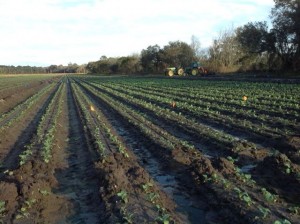In Charleston, South Carolina, Brian Ward (in photo below) is supervising and evaluating the first Eastern Broccoli Quality trial of the year at the Clemson Coastal Research and Education Center. Quality trials let us compare new hybrids and current commercial Continue reading Broccoli evaluations starting in South Carolina
All posts by je11@cornell.edu
First trial at new site in Georgia
Broccoli is ready for harvest at a new Eastern Broccoli trial site in Tifton, GA. Tim Coolong of the University of Georgia is supervising the trial, which was transplanted at Lewis Taylor Farms in late February. Broccoli hybrids grown in this commercial production Continue reading First trial at new site in Georgia
EDUCATIONAL EVENTS SHOWCASE EASTERN BROCCOLI TRIALS
Eastern Broccoli Project trials will be on display this week as part of educational events in three states.
On Wednesday, August 19, a production trial will be featured in a Fresh Market Vegetable Twilight Meeting at W.D. Henry and Sons in Eden, NY. As part of the event, which runs from 6 to 8:30 pm, Cornell Vegetable Specialist Christy Hoepting and project director Thomas Björkman will lead a tour and discussion of Eastern Broccoli Project trials.
Also on August 19, Carroll County Virginia Extension Agent Suzanne Slack will host an informational session on growing summer broccoli. The event, which is advertised on the Carroll County Extension Facebook page, takes place at 6 pm on at Light’s Farm in Laurel Fork, VA.
From 8:30 am to 12:30 pm on August 20, broccoli project trials will be part of the Alternative Crops and Organics Research Highlights Tour held by Jeanine Davis and Margaret Bloomquist at North Carolina State University’s research station in Waynesville, NC. See http://ncalternativecropsandorganics.blogspot.com for more information.
New GAPs Resources on Eastern Broccoli website
Becoming GAP-certified is essential for commercial growers, but the process can seem daunting – where do you start?!
The GAPs Resources page of the Eastern Broccoli website now features an introduction to Good Agricultural Practices for broccoli growers, including reasons to get certified, an overview of the certification process, and a look at broccoli production with GAPs. Please check out the information if you are growing or thinking about growing broccoli but aren’t yet GAP-certified.
Winter broccoli trials in progress in Florida
Dr. Monica Ozores-Hampton and Dr. Lincoln Zotarelli supervise broccoli plantings at new trial locations in Immokalee and Hastings, Florida. These large-scale trials feature an industry standard broccoli variety and two newer commercial hybrids that have displayed superior quality under stressful growing conditions in advanced screening trials. Broccoli varieties will be evaluated based on production-relevant criteria such as yield, number of cuts to harvest, and field holding time. The Hastings trial was direct-seeded in December 2013, while broccoli in the Immokalee trial was transplanted in mid-January 2014. Harvest and evaluation are expected in late winter/early spring 2014. With the addition of the Immokalee and Hastings sites, the Eastern Broccoli project now has trials running in at least one eastern location during every season of the year.

Webinar on U.S. Food Distribution System
One goal of this project is to increase the availability of eastern-grown broccoli in eastern markets. But how does that broccoli get from the site of production to the point of purchase by consumers?
In a webinar available for viewing on the project website, economist Miguel Gómez discusses the history and evolution of the U.S. food distribution system, the organization and behavior of its three main channels, and the role of intermediaries in bringing food products from the farm to the American table.
Case studies explain how one retail chain has impacted the structure of the distribution system; why changes in product supply are not always reflected in retail prices; why sales of private label products are growing; and how Community Supported Agriculture (CSA) programs have increased opportunities for growers to market directly to consumers.
The presentation includes an exploration of trends in food expenditures and concludes with projections from industry executives on expected changes in retail food distribution.
To stream the webinar or view a pdf of the slides, visit the project reports page of the website and click on the appropriate link.

